Misc
[INTERVIEW] Talking All Things ‘Hell Motel’ with Ian Carpenter
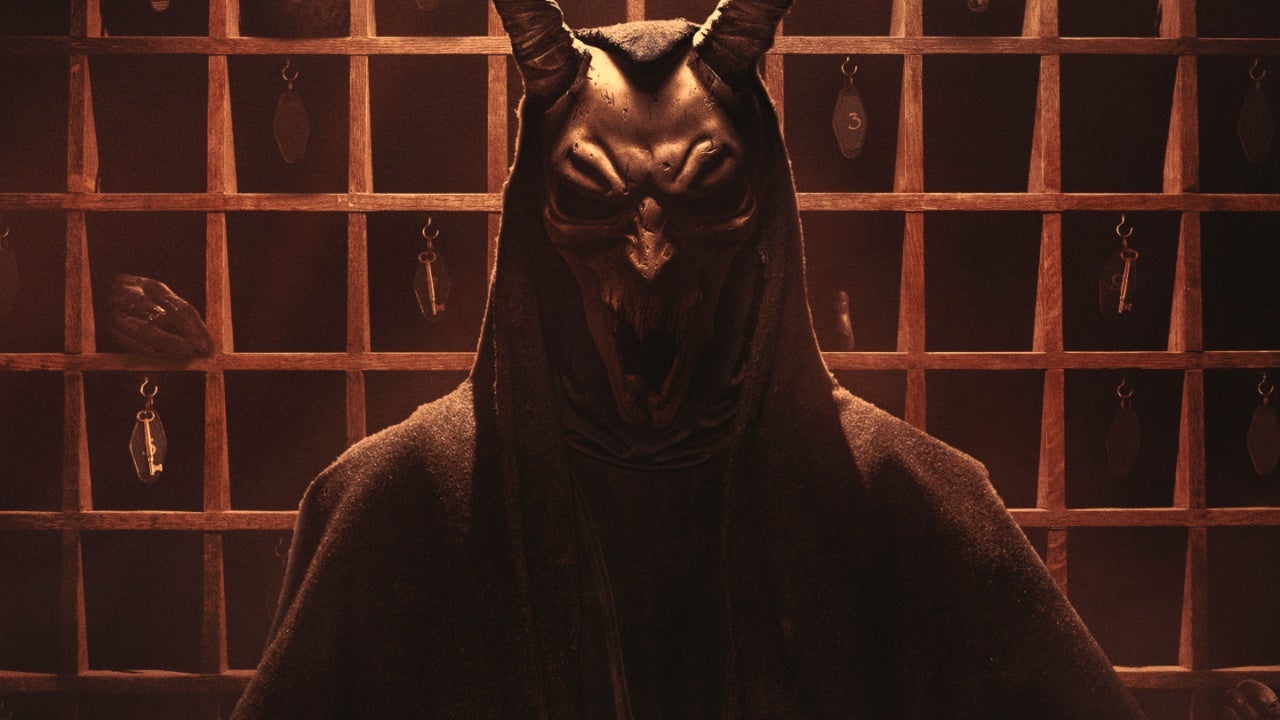
My fellow couch potatoes know how hard it is to find quality horror television. Too many series have no faith in their audiences, so we get overexplained to death. Many others run into issues with networks and can only give us so much blood and violence. These are a few reasons why my favorite Shudder series, Slasher, stands out from the crowd by avoiding those pitfalls. The last three seasons are criminally underrated, and I have been waiting to see what the team would do next. Luckily, the wait is over because Hell Motel is coming to a television near you this June.
Hell Motel follows a group of true crime obsessives invited to the opening weekend of the newly renovated Cold River Motel. The motel is the site of a 30-year-old unsolved satanic mass murder. The group soon discovers that history might be repeating itself as they each begin meeting their grisly demise one by one. The series is the brainchild of creators Aaron Martin and Ian Carpenter.
Upon hearing that Martin and Carpenter were creating a new horror anthology and bringing most of their Slasher crew with them, I ran to my editor’s inbox to call dibs on interviews. I crowned myself the Hell Motel Lady of Horror Press and started sending emails. That is how I ended up picking Ian Carpenter’s brain about Hell Motel. I figured as co-creator, executive producer, and showrunner, Carpenter would be a great place to start looking for answers. We discuss what it was like reassembling so much of the Slasher squad for a new series, how the team manages to keep the audience guessing, and (obviously) haunted motels. Read on for a spoiler-free discussion about this new bloody series bringing mayhem, murder, and mystery to Shudder this summer.
An Interview with Hell Motel Co-Creator Ian Carpenter
Sharai Bohannon: You and Aaron Martin have been pretty frequent collaborators since Slasher: Solstice. So, I was giddy when I saw you were the co-creators of Hell Motel. What do you think makes this partnership work so well? What unique things do you think you both bring to the table?
Ian Carpenter: Great question, and it feels strange to answer it with him absent. I think it works well because we have lots of similar interests and loves (humor, crazy situations for extreme but grounded characters, a well-turned mystery, sweetness, meanness, and camp). I think our tastes have moved a little in each other’s directions, but an essential part of our creative chemistry is the ways in which we’re different.
So, we can surprise each other. That’s very present in our back-and-forth on scripts. Our humor has some differences, and we’ll each push different boundaries. It has reached a Lennon/McCartney state where the divisions are very blurry, and all the more blurry because we’re now great friends. I don’t know that I’d want to dissect it.
There are so many other familiar names behind the camera and familiar faces on screen. I think it says a lot about the culture you all created on Slasher that so much of the troupe keeps turning up (in Hell Motel and Guess Who). Are you at the point where you write with specific actors in mind already? Or do you write it and see where it might be fun to put the people who are returning?
It’s a bit of both. One or two actors will come up for one or two characters. We might write with them in mind, but then we also like to keep the characters clean of the cast. So, we let them live and grow independently. Then, when we get near the end of writing all the scripts, we start talking about who it could be. Sometimes that’s an unranked list of four great actors for one part, and you figure out, “Well, if we get So-and-So for this, Actor X would be a great foil for her in this part.” If I laid out the almost cast core Slasher actor moments (often impacted by scheduling), your mind, like mine, would explode. The crazy thing is that it always leads to actors in parts you then can’t imagine being played by anyone else.
Many of you have worked together for almost a decade between Slasher and Hell Motel. However, each season and each show provides new challenges and opportunities. What is one thing you learned, or maybe realized for the first time, about yourself (or your creative team) while working on Hell Motel?
It helps to have a witch, like Aaron’s mother, show up and make sure the weather does exactly what you need it to.
Motels are always interesting locations for horror. They are these big looming presences that become almost another character in movies like Psycho, Identity, Vacancy, etc. How did you and Aaron settle on telling a story that unfolds in a motel? What excited you about tackling something so location-specific with this new anthology series?
We’re both super aware of all the great movies set in motels, so it feels like a ripe location. There’s something about the vulnerability of everyone moving through those spaces, off-kilter because they’re out of their homes, in danger because they don’t know the kind of monsters who could be right next door, just like it is for all of us in real life. This really worked for the famous murder-site story we wanted to tell. You just know someone’s going to (if they haven’t already) Airbnb a home that hosted a terrible murder…
Many of us have a few stories about motels (or Airbnbs) that still haunt us (or make us itch). Do you have one that you’re willing to share?
Nothing crazy. My wife is very interested in ghost hunting, so we’ve visited many haunted locations. I’ve had a door slammed on my back in a 100% empty room when I was by myself, a ball at a haunted school house moved non-stop, two feet in front of me. But having the entire Inn at the Falls in Bracebridge to ourselves, no other guests, no staff, felt crazy given its haunted history. For some reason, creeping around there at night, just the two of us, was way scarier than the other moments. As with horror, it’s usually the anticipation or fear of what’s going to happen that freaks me out. Actual activity kind of delights me…but, maybe I’ve been lucky with what’s happened…
Many people will show up thinking this will be a standard motel horror situation and be pleasantly surprised. There is already so much to unpack in just the first two episodes. It’s diving into influencer culture, true crime fanatics, and an actor struggling to find her place after the industry has spit her out. It’s feeling like it’s leaning into the idea of trends and, more importantly, what the things we make trendy say about us as a society. If I’m not off base (I’m only two episodes in), what are you hoping audiences take away from this? Do you think they’ll be able to see themselves in the mirror the show is holding up to all of us?
It’s exactly what you’re saying. We wanted to hold the mirror up to them, our fans, and ourselves as both horror fans and creators. Why are we drawn to these awful stories? What do we get out of them? I know many (or maybe even most) of us have our limits and no-go zones (like kids, animals, or SA). However, if that sense of morality or sensitivity or trauma, exists in us as viewers and creators, why is so much other awfulness okay? I’ve got lots of thoughts as to the why and what we all get out of it, but I’d rather hear our audiences’ experiences. And, make no mistake, I LOVE these kind of stories, but like all horror fiends, I get questioned all the time by friends and family who don’t like or understand the genre. So, it felt like time for us to do that from a fan perspective.
One of the things I love about Hell Motel is the examination of true crime content creators. It’s a very murky business, and mileage varies from person to person. It feels like we have differing viewpoints on the genre as a whole (and also the people who benefit from it). It’s a sticky subject but is also always trending. What inspired you and Aaron to go in this direction? Also, are either of you true crime fans?
We’re both much more interested in fictional crime and horror, but we dive into true crime and the fictional remakes that are trending these days. As creators, you’re always wondering about the factual hell that some people have experienced or wrought.
I’m leaning in for this journey that Paige (Paula Brancati) is on as a former scream queen who has been all but forgotten. I think that happens with women over the age of 25 in all fields. I’m rooting for her character to live just because she’s so relatable. I have to ask, is this character influenced by specific horror actresses? Or is it just kind of a general observation of what happens to women society decides are past their prime as soon as our frontal lobes finish developing?
Hard-core horror fans and creators are super loyal to the actresses who affected us all so much. But, for every Barbara Crampton and Jamie Lee Curtis, there are those unsung heroines who ran half naked, covered in blood on freezing cold nights, acting their guts out, who have just come and gone. Anytime I’m watching 70s and 80s horror, I’m looking up what happened to certain actors, and there’s lots of sad stories out there, like Robin Stille from Slumber Party Massacre. It was the pervasiveness of that brutal history, rather than one particular person.
You’re wearing a ton of hats at Hell Motel, and I noticed one of those positions is serving as the showrunner. We all know that is not a job for the weak as it requires you to be everything everywhere all at once. However, I think this scans for you because it’s something you’re pretty great at and seem to enjoy doing. So, what is your favorite part of this stressful title? What gets you excited enough about it to volunteer as tribute?
Thanks! I mean, to me, it’s the most creative position. Aaron and I have built this thing, and I want to see every inch of it reach what we think is its greatest potential. To make sure it’s what we intended and love. The best part is working with other artists, like Director Adam MacDonald, the amazing DOPs, Production Designers, Editors, Composers, Costume Designers, Hair, Make-up, and our amazing prosthetics team at Black Spot. The list, which is dangerous to start for fear of excluding people, goes on and on. The genre demands a lot from everyone on the crew. So, if I can inspire those people to take creative risks, to bring their A-game, to get them to push my boundaries and blow me away, it’s an incredible experience. And I count every last one of them as part of it. It’s a list with over 150 names on it. I’m grateful for all their involvement.
While we’re here, what is one thing you wish you had known before accepting your first showrunner position on Slasher: Solstice?
Because I had wanted to do it, I was studying it on every gig I had before Slasher. It was a study of leadership, and I asked the showrunners I worked with to expose me to anything I didn’t understand or know about. At one point, when I was between gigs, I thought, I don’t know enough about post [production]. So, I reached out to friends with shows and asked if I could shadow any of those moments. The only person who said yes was Aaron. And, pointedly, the thing he invited me to was the mix for the pilot of season 2 of Slasher. Having Aaron on the end of the phone when I started on season 3 made it all a little like showrunner school. I was really fortunate to have all of that experience available to me.
One of the many reasons I love your work is because you have mastered the art of the kill. Not trying to spoil anything, but what is your favorite kill this season? Is it possible to give us a hint?
Ha. It changed as we shot and edited, but in the end, there’s a callback kill just past halfway in the season. At night, in a rainy forest – and the victim’s performance and the direction and how it looks, all guts me.
It’s really special to me and beautifully emotional.
We live in a time where many movies and shows reveal everything within the first five minutes. However, part of the fun is figuring out the whodunnit. One of the things I love about what you and Aaron are doing in the slasher genre is this refusal to write down to your audiences. You’re making shows for smart people who do want to dissect the plot and dig into the themes.
So, first off, thank you for making smart TV. Secondly, how hard is it to stay ahead of your audience, who has watched horror forever and will overanalyze every single detail?
Another great question. It’s really hard, verging on impossible. With a whodunnit, that’s always present, right? I mean…if the killer comes out of the blue, it’ll dissatisfy everyone. So, you absolutely must have tips, and clues, and motivations that track, but if you tip it too much, that doesn’t work (though you can see we’re playing with that this season). This is where our execs at Shaftesbury, Hollywood Suite, and Shudder come into play.
They’re our first readers. A big plus with David Kine at Hollywood Suite and Nick [Lazo] and Sam [Zimmerman] at Shudder is they have an amazing story sense. Between Nick and Sam, they’ve seen everything in horror. A great note in our first season working with them that came up a couple times is, “Our audience will totally figure it out if this moment happens.” Our audience is next-level, and they’re combing through everything and assembling all the possibilities. But that kind of engagement is super exciting and motivates us even more.
Hell Motel premieres on Shudder with a two-part episode on Tuesday, June 17.
Misc
Our Halloween Giveaway Is Here!
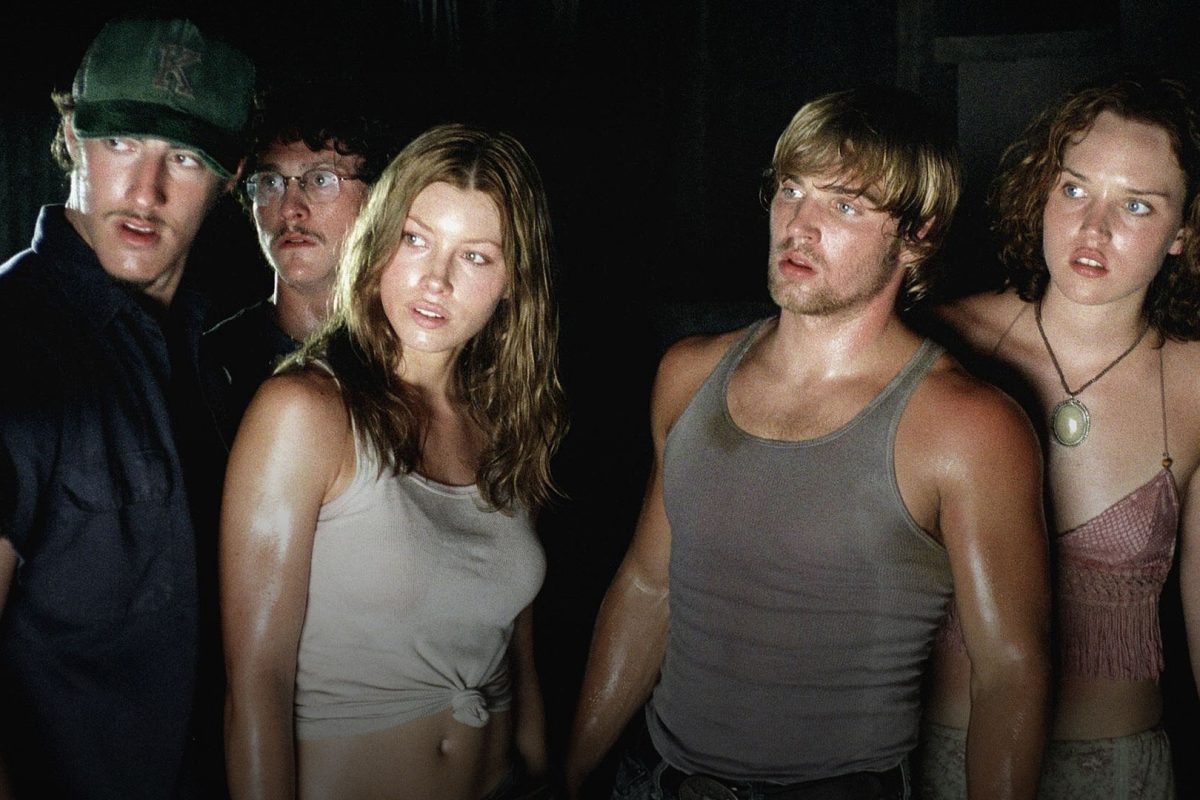
Enter Our Halloween Giveaway!
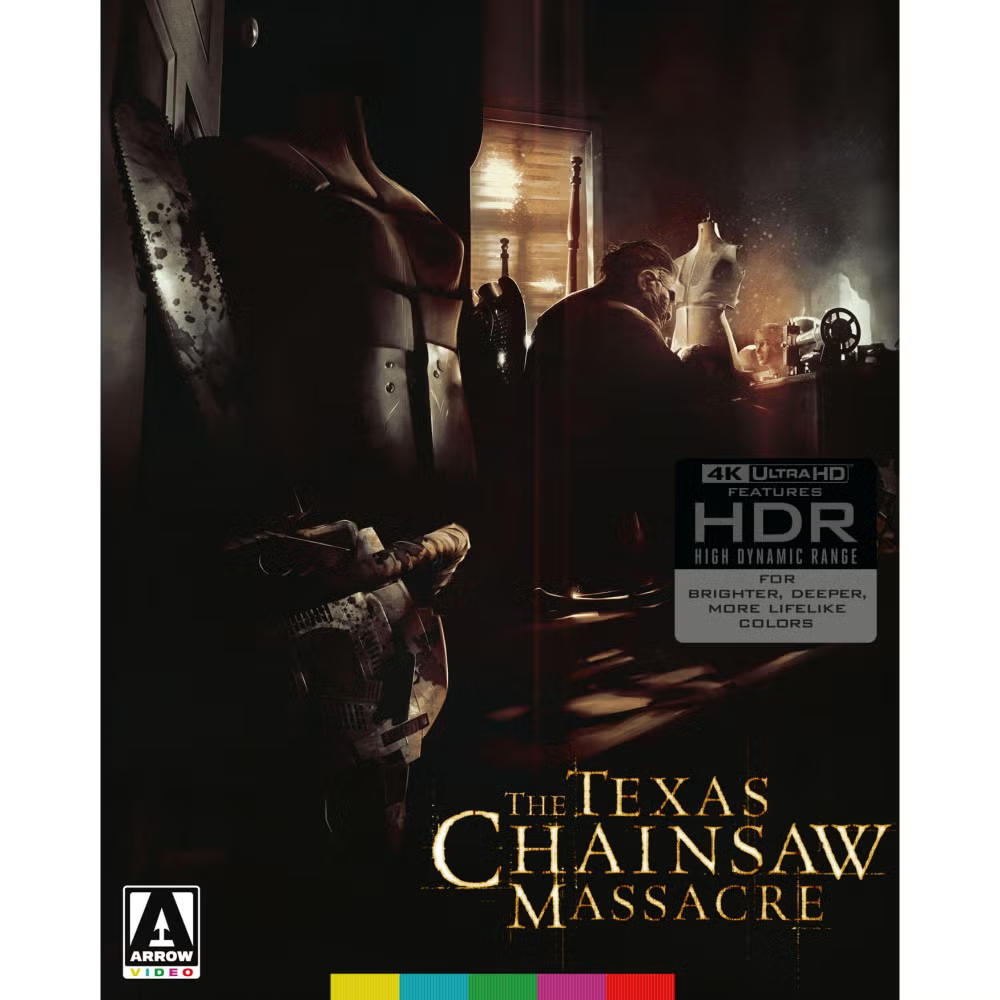
How to Enter:
Step 1. Make sure to FOLLOW US ON FACEBOOK AND JOIN OUR FACEBOOK GROUP!
Step 2. LIKE AND SHARE the giveaway post!
Step 3. This is the most important step, email us at contact@horrorpress.com with your FULL Facebook name (so we can verify you’re in the group) and who your favorite character is from the Texas Chainsaw franchise.
**Giveaway entries are limited to addresses in the United States.**
**All entries must be 18 or older to enter**
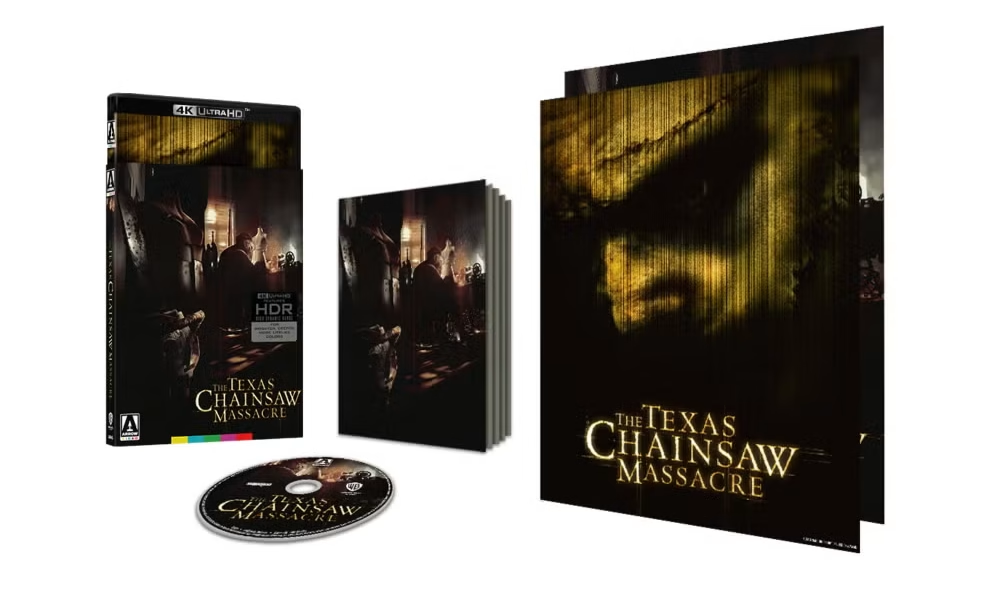
What You’ll Win
The Texas Chainsaw Massacre (2003) Limited Edition 4K UHD from Arrow Video
- 4K (2160p) Ultra HD Blu-ray presentation in Dolby Vision (HDR10 compatible)
- Original DTS-HD MA 7.1 and 5.1 surround audio and lossless stereo audio
- Optional English subtitles for the deaf and hard of hearing
- Brand new audio commentary with Dread Central co-founder Steve “Uncle Creepy” Barton and co-host of The Spooky Picture Show podcast Chris MacGibbon
- Archival audio commentary with director Marcus Nispel, producer Michael Bay, executive producers Brad Fuller and Andrew Form and New Line Cinema founder Robert Shaye
- Archival audio commentary with Marcus Nispel, director of photography Daniel Pearl, production designer Greg Blair, art director Scott Gallager, sound supervisor Trevor Jolly and composer Steve Jablonsky
- Archival audio commentary with Marcus Nispel, Michael Bay, writer Scott Kosar, Brad Fuller, Andrew Form and actors Jessica Biel, Erica Leerhsen, Eric Balfour Jonathan Tucker, Mike Vogel and Andrew Bryniarski
- Reimagining a Classic, a brand new interview with director Marcus Nispel
- Shadows of Yesteryear, a brand new interview with cinematographer Daniel Pearl
- The Lost Leatherface, a brand new interview with actor Brett Wagner
- Masks and Massacres, a brand new interview with makeup effects artist Scott Stoddard
- Chainsaw Symphony, a brand new interview with composer Steve Jablonsky
- Chainsaw Redux: Making A Massacre, a making-of documentary
- Ed Gein: The Ghoul of Plainfield, an in-depth look at the infamous killer who inspired the character of Leatherface
- Severed Parts, a look at the cutting room floor and some of the scenes excised from the final edit
- Deleted scenes including an alternate opening and ending
- Screen tests for Jessica Biel, Eric Balfour and Erica Leerhsen
- Behind-the-scenes featurette
- Cast and crew interviews
- Theatrical trailers and TV spots
- Concept art galleries
- Reversible sleeve featuring original and newly commissioned artwork by Aaron Lea
- Double-sided foldout poster featuring original and newly commissioned artwork by Aaron Lea
- Illustrated collector’s booklet featuring new writing on the film by Michael Gingold
Misc
NYCC 2025 Horror Highlights: A Sneak Peek at ‘The Lost Boys’ Musical, ‘Resident Evil: Requiem,’ and More!
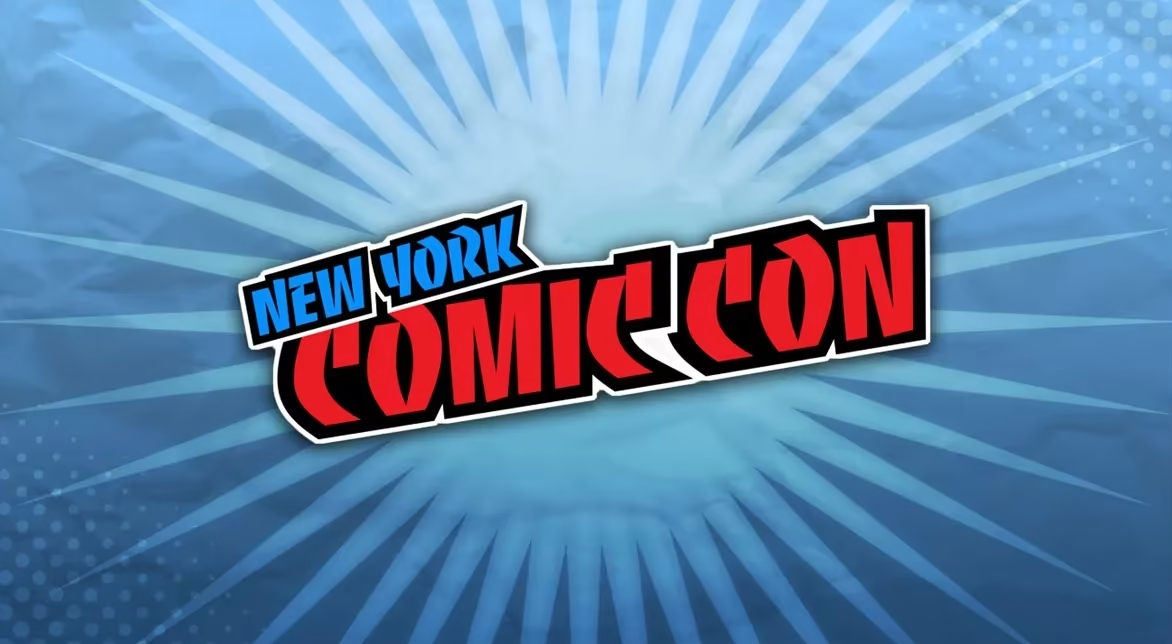
As soon as New York Comic Con announced that its 2025 theme would be “haunted,” I started lacing up my comfy shoes and making a beeline for the Javitz Center! Horror has always been represented at the con, but it felt fitting that it should play a central role in this year’s event at a time when the genre seems more popular than ever.
From beloved family-friendly properties like The Nightmare Before Christmas to pants-dampening titles like the upcoming Resident Evil: Requiem, horror appeared in countless shapes and forms. Here are all the best and scariest insights I gleaned from the show floor, panel rooms, and pop-ups of New York Comic Con 2025!
Our NYCC 2025 Horror Highlights
Resident Evil: Requiem Is Going to Test Your Bladder Strength
Full disclaimer: I’m not a gamer. I’m honestly pretty bad at games, which made my Resident Evil: Requiem play session all the more frightening because I was convinced that everyone around me would realize I’m a fraud. But with easy-to-grasp controls, even for a newb like me, the latest installment in the iconic horror franchise quickly sucked me in and left me on edge for entirely different reasons.
During my 30-minute session, I was introduced to FBI analyst Grace Ashcroft, Requiem’s central character. She swims to consciousness to find herself strapped upside down on a gurney with a needle in her arm, siphoning her blood. After Grace managed to free herself, the controls were handed over to me to explore the creepy facility through Grace’s eyes, looking for a fuse. Some spaces were bathed in red light; others were lit only by flickering bulbs that left me white-knuckling the controller, waiting for something to emerge from the shadows and swallow me whole, not helped by Grace’s anxious, stuttering breathing in my ear.
I took a moment to appreciate how detailed video games have become since my childhood experiences playing Evil Dead: Hail to the King on the original PlayStation (seriously, you can see the dust drifting in beams of light now?!), only for the sound of movement somewhere in the facility to yank me back to the present. I renewed my frantic search for the fuse, only to run blindly into a pitch-black room and encounter something enormous that dragged me into the darkness. Sorry, Grace!
You can find out what happens next when Resident Evil: Requiem releases for the PlayStation 5, Xbox Series X|S, PC, and Nintendo Switch 2 on February 27, 2026.
Megan Fox Is Among the New Cast Members in Five Nights at Freddy’s 2—And Blumhouse Hasn’t Given Up on Its Other m3gan Yet
Blumhouse made several announcements at their NYCC panel, most notably that Megan Fox (Jennifer’s Body) is voicing Toy Chica in director Emma Tammi’s highly anticipated sequel Five Nights at Freddy’s 2, coming to theaters on December 5. Other new additions to the cast include YouTuber Matthew Patrick, aka MatPat, who cameoed in the first movie and will voice Toy Bonnie, and Kellen Goff, who has voiced multiple characters in the game series and will now lend his pipes to Toy Freddy.
I’m interested in Five Nights at Freddy’s 2, not least because my best friend is terrified of the franchise and makes a wildly entertaining moviegoing companion—but I’m more interested in the future of another Blumhouse franchise, M3GAN. After the sequel underperformed, likely due in part to its hard genre pivot away from horror and into action territory, the future of the killer doll is uncertain. But in a special industry presentation on “The Business of Fear,” Jason Blum revealed that “we’re all working to keep M3GAN alive,” adding that Blumhouse is exploring other potential mediums before trying to resurrect her on film.
Does that mean a M3GAN video game might come our way in the future, or perhaps a TV series? I don’t know, but I have a feeling this isn’t the last we’ve seen of the silicone diva.
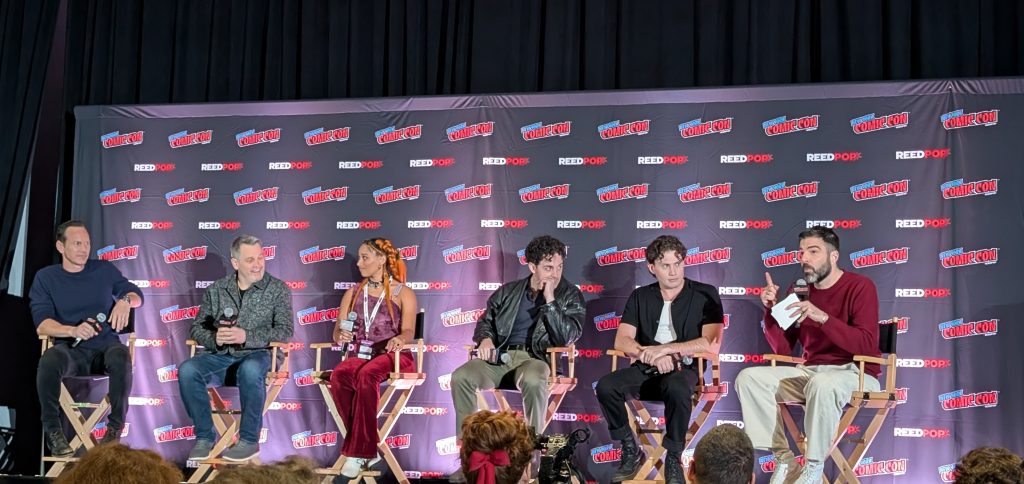
Photo taken by Samantha McLaren.
The Lost Boys: A New Musical Will Feature Flying Stunts and a Live Vampire Band
My queer heart is a sucker for musical adaptations of horror films I love, so you can be certain that I’ll be heading down to the Santa Carla Boulevard—aka Broadway’s Palace Theater—for The Lost Boys: A New Musical, which begins previews on March 27, 2026. At their NYCC panel, producer Patrick Wilson (The Conjuring franchise), director Michael Arden (Maybe Happy Ending), and cast members LJ Benet, Ali Louis Bourzgui, and Maria Wirries revealed why they feel Joel Schumacher’s 1987 classic translates so well to the stage, and what audiences can look forward to.
“There’s something that I see with both horror movies, musicals, and superhero movies—there’s an element of melodrama that’s really rewarding,” says Wilson, who began his career in musical theater and worked with Schumacher on the director’s 2004 film adaptation of The Phantom of the Opera. “Some people view it as camp, but there’s a reality of it being heightened that felt like this story cemented itself so much to being a musical.”
“They’re a biker gang, after all, and there’s a level of theatricality to that in and of itself,” says Arden. “Our biker gang also happens to play instruments.”
That’s right: the vampires will be playing instruments live on stage, which made casting twice as hard. Ali Louis Bourzgui, who plays David, the character portrayed by Kiefer Sutherland in the film, reveals that he plays guitar. And that wasn’t the only unusual request in the casting call: auditions included a flying test. (Presumably wires were involved, unless Arden has found himself a real cabal of vampires in his cast.)
Other highlights that fans can look forward to include killer music from one of Arden’s favorite bands, The Rescues. You can listen to the song “Have to Have You” right now, featuring instrumentals from Slash. The director also teases that many fan-favorite moments from the film will feature in some way in the musical, including the bridge scene and, yes, even the sexy saxophone guy.
Greg Nicotero’s Guts & Glory Marks a New Challenge for a Legend of the Business
If you like looking at gnarly practical effects in horror movies, chances are you’re familiar with Greg Nicotero’s work, whether you realize it or not. The legendary SFX artist has worked on everything from George Romero’s Day of the Dead and Sam Raimi’s Evil Dead II to Kill Bill and, more recently, The Walking Dead. The impressive extent of his resume was made clear at the panel “Shudder is Here to Scare the S*** Out of You,” in which almost any film mentioned by the other panelists was met by a small smile and a humble murmur of “worked on that” into the mic, often followed by a wild anecdote. Nicotero seems like the most interesting man in the world to grab a drink with, and his new horror competition show for Shudder—Guts & Glory—will let us see more of the man behind the makeup brush.
“Guts & Glory is one of the most fun times I’ve had on a show,” Nicotero says, teasing that the series is “part Sam Raimi, part Halloween Horror Nights, and part Survivor.”
In the six-episode first season, contestants are dropped into an Alabama swamp, where there’s an urban legend about an evil spirit. “One of the contestants gets possessed by the evil spirit, people start dying off, but in the meantime, they’re still competing and there’s a prize,” Nicotero explains.
Guts & Glory is effects-heavy, which was challenging to do in an unscripted series relying on real people’s real-time reactions. “You do a movie, you can cut and try it again,” Nicotero explains. “[This] was completely out of my wheelhouse and out of my comfort zone, but I’m really, really proud of it.”
Nicotero’s Creepshow was one of the first original shows to debut on Shudder, so he’s truly part of the DNA of the horror streamer, which celebrated its 10th anniversary this year. Guts & Glory premieres on October 14 as part of Shudder’s Season of Screams programming.
Horror Short The Littles Deserves the Big-Screen Feature Treatment
Some short films are perfectly suited to their bite-sized format, while others contain the seeds of something much bigger. At the New York Premiere of The Littles, a new short written and directed by American Horror Story producer Andrew Duplessie, I could immediately see the potential for the feature film that Duplessie hopes to make.
Equal parts charming and unsettling, The Littles stars M3GAN’s Violet McGraw as a little girl with a loose floorboard in her bedroom. One night, a scuffling sound and a crack of light between the boards lead the little girl to discover that her family isn’t alone in the house…
Duplessie says The Littles was inspired by his own experiences growing up in a creaky old house with a no-doubt overactive imagination. The short features creepy-cute stop-motion animation from Anthony Scott (The Nightmare Before Christmas), puppets by Katy Strutz (Guillermo del Toro’s Pinocchio), and some truly adorable miniature sets by Aiden Creates, all blended perfectly with the live-action scenes. Check it out if it’s playing at a festival near you, and watch this space for a (fingers-crossed) future feature!
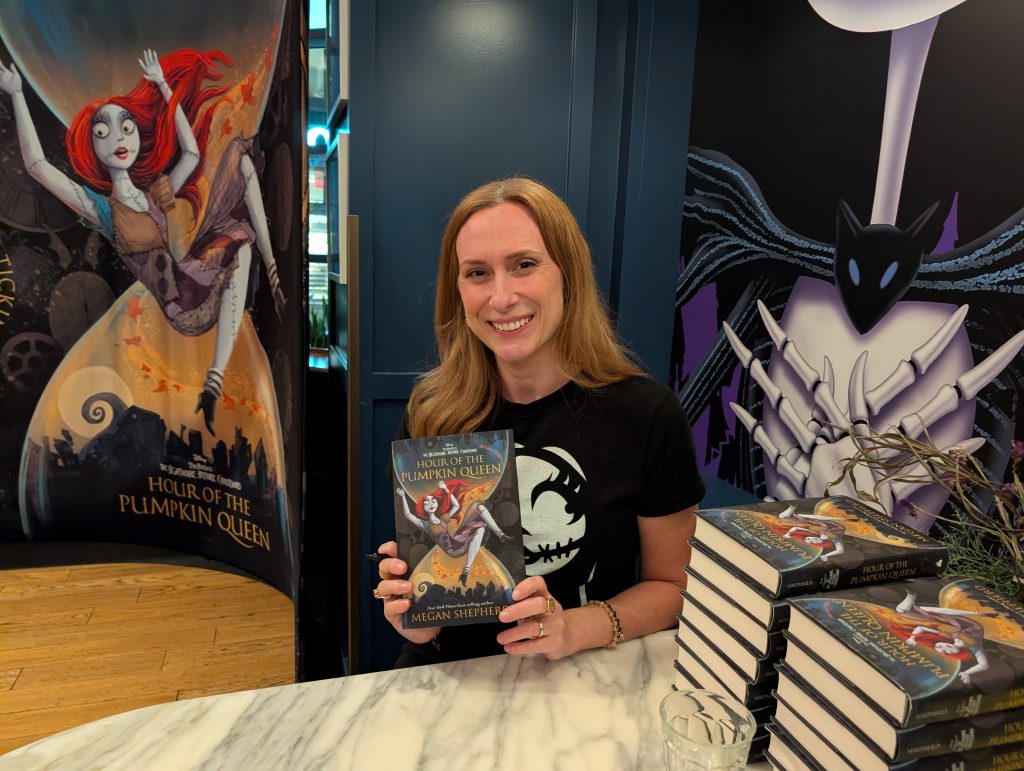
Photo taken by Samantha McLaren.
Disney Publishing’s New The Nightmare Before Christmas Tie-in Novel Welcomes Younger Fans into the Scary Fun
NYCC’s horror happenings weren’t all geared toward an adult audience. Disney Publishing took over Daily Provisions Manhattan West for a pop-up experience inspired by The Nightmare Before Christmas, featuring themed food and drinks like a delectable Pumpkin Potion coffee that I could honestly drink all season long.
At a media and creator event in the space, I took a look at the newly released Hour of the Pumpkin Queen from New York Times best-selling author Megan Shepherd, who also wrote the official novelization of The Nightmare Before Christmas for the film’s 30th anniversary in 2023. In this new tie-in novel, Sally and her rag doll apprentice, Luna, embark on a time-bending adventure to save Jack Skellington and Halloween Town after falling through a mysterious portal.
I was gifted a copy of the book by Disney, but all opinions are my own here. I’m looking forward to giving it a read during the inevitable Halloween hangover that takes place in November, before likely passing it on to my young nieces when they’re old enough. It’s a full novel, not a picture book, so definitely geared more toward a YA audience, but between the beautiful artwork on the cover and the seasonal theme, it might just be the perfect gift for the budding horror lover in your life.
That’s a wrap on New York Comic Con 2025! Be sure to bookmark Horror Press if you haven’t already so you never miss our coverage of conventions, festivals, and more.

























